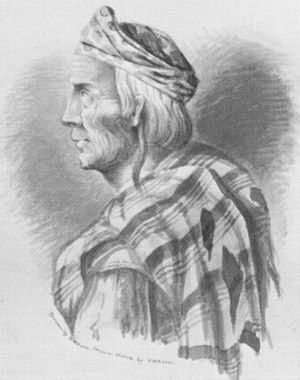Narbona facts for kids
Quick facts for kids
Narbona
|
|
|---|---|
 |
|
| Born | 1766 |
| Died | August 31, 1849 (aged 82–83) |
| Allegiance | Navajo |
| Rank | Chief |
| Battles/wars | Navajo Wars |
Narbona (1766 – August 31, 1849) was an important Navajo leader. He played a big role in the Navajo Wars, which were conflicts between the Navajo people and other groups. Sadly, he was killed during a fight with U.S. soldiers in 1849.
Contents
Who Was Narbona?
Narbona was one of the richest Navajo people of his time. His large family group owned many sheep and horses. The Navajo people were very independent. They did not have one single "chief" who ruled everyone. However, Narbona was very respected and influential. He gained this respect because of his wealth, his good reputation, and his age. This made him a key person when dealing with outsiders.
Narbona's Early Leadership
Narbona became a very important tribal leader after a sad event in 1822. About 24 Navajo leaders were killed at Jemez Pueblo. They were traveling to a peace meeting with the New Mexican government. In 1835, Narbona led the Navajo to a major victory. They ambushed a Mexican group in the Chuska Mountains. This battle was led by Captain Blas de Hinojos. The place where this battle happened is now called Narbona Pass. It was once known as Copper Pass.
Meeting with the Americans
In 1849, Narbona and hundreds of his warriors went to meet a group led by Colonel John M. Washington. They wanted to talk about peace. The Americans, sometimes called "New Men," had recently taken control of the Southwestern United States from Mexico. The U.S. group included both U.S. soldiers and local New Mexican helpers.
The Peace Talk and Conflict
There were some misunderstandings during the meeting. But eventually, translators helped everyone agree on peace terms. As the meeting ended, a young Navajo warrior named Sadoval began riding his horse around. He was encouraging other Navajo warriors to break the new treaty. At this point, a New Mexican officer claimed that a horse being ridden by a Navajo warrior belonged to him. Colonel Washington felt he had to support his officer. He demanded that the horse be returned right away. The Navajo refused, and the horse and its rider left.
Colonel Washington then ordered his troops to get their cannon ready to fire. He said they would shoot if the Navajo did not return the horse. The Navajo again said no. So, the Americans opened fire with their cannon and rifles. Narbona was badly wounded in this attack. His sons buried him in the traditional Navajo way.
See also

